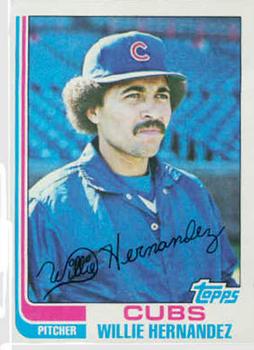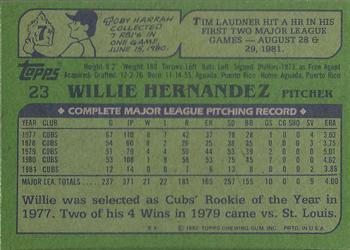Who Can It Be Now?
While the card says "Willie", we will call him what he preferred to be called: Guillermo. Guillermo Hernandez Villanueva was born in Puerto Rico in 1954 in Aguada. He attended high school in Puerto Rico as well prior to being signed as an amateur free agent by the Phillies in 1973. Before 1990, players out of Puerto Rico were exempt from passing through the amateur draft and were able to be signed once they hit age 16. Once 1990 came and the Puerto Ricans had to go through the draft, players from P.R. had to wait to sign until they completed high school. This rule is blamed for the fact that baseball is a dying sport in the Commonwealth of Puerto Rico, as detailed in this 2012 New York Times article.
Hernandez signed at age 18 with the Phillies, but he did not pitch in their minor league system until the next year -- 1974. Hernandez was a starter through his minor league career with the Phillies and enjoyed a very successful season at age 20, which he split between AA and AAA. He posted a 14-6 record and a 3.11 ERA over the two levels, and his strikeouts actually increased in AAA over AA on a per-nine-inning basis. He struggled somewhat at AAA at age 21 in 1976, but those struggles did not deter the Cubs from selecting him in the Rule 5 draft in December of 1976.
He stayed in the major leagues with the Cubs until the 1981 season. The Cubs sent him down to Iowa to take another crack at being a starter and to get work during the strike. Even though he was in his fifth season in the majors, Hernandez was still just 26 years old, so the work could not have hurt.
In reality and as his biography on the SABR website points out, the best thing that happened to Hernandez was playing winter ball after the 1982 season and, then, going to spring training with the Cubs in 1983. In the winter league, former Baltimore Oriole Mike Cuellar taught Hernandez the screwball -- a pitch used to great effect by Fernando Valenzuela in 1981. Then, in spring training, Hernandez worked with fellow Cub Fergie Jenkins and learned the cut fastball. The cutter gave him a pitch to bust righty hitters inside, and it gave the perfect set up for the screwball.
The rest, as they say, is history. Hernandez started using the cutter and the screwball some after the Cubs traded him to the Phillies in May of 1983. The Phillies used Hernandez exclusively as a relief pitcher once they got him. He appeared in three World Series games against the eventual champion Orioles that year, pitching four scoreless innings and allowing just two baserunners -- one on a walk and one hit batsman.
The next spring, Detroit saw Hernandez as the lefty reliever they needed to augment Aurelio Lopez -- Señor Smoke -- at the back of the bullpen and traded away up-and-coming outfielder Glenn Wilson to the Phillies (with John Wockenfuss) for Dave Bergman and Hernandez. Sparky Anderson rode Hernandez hard -- having Hernandez appear in 80 of the Tigers 162 games, finishing 68 and saving 32 while pitching 140-1/3 innings. Hernandez responded by striking out 112, walking just 44, and giving up only 96 hits. For that season, Hernandez was both the AL Cy Young Award winner and the AL MVP in addition to being an all-star.
After that 1984 season, Hernandez remained with the Tigers until the end of his career after the 1989 season. He never approached the heights of his 1984 season -- and with that workload in relief, that should not come as any surprise -- and even became a lightning rod for Tigers fans' disapproval when something went wrong. Even Sparky Anderson said that.
Hernandez also gained some notoriety for showing up as a New York Yankee in 1995 as a replacement player during the spring training portion of the 1994-1995 lockout/strike. Hernandez apparently had been an agent and working for a steel manufacturing firm before coming back, but felt like he had not been given a fair chance to come back after elbow surgery in 1989. Needless to say, when the regular players came back, Hernandez returned to Puerto Rico.
After baseball, a Toledo newspaper noted that Hernandez was spending his time five years ago as, "a cattle farm owner in the milk business in San Domingo[, Puerto Rico]."
Rabbit Is Rich
John Updike won a Pulitzer Prize for Fiction in 1982 with his novel Rabbit Is Rich. Here, the category will be used to talk about guys who at some point in their career famously held out or got a big, improved contract in some fashion -- and, more importantly, how it came about.
In Hernandez's case, our story comes from October of 1984. At that point in time under baseball's collective bargaining agreement, a player could demand a trade by a certain point in the offseason from his current team. If the player was not traded and did not withdraw the trade request -- read as: got a better contract from his new team -- then the player would become a free agent as of March 15.
Hernandez was aware of this rule. In the midst of the World Series, he demanded a trade. By doing so, he was seeking in essence to void the contract he signed with the Cubs prior to his two trades and work out an improved contract with Detroit. The gambit worked, as he signed a five-year, $5.2 million contract with Detroit prior to the 1985 season. It would turn out to be his final contract as a major league baseball player, as well. And maybe, just maybe, demanding a trade in the middle of a World Series is why Tigers fans were quick to boo Hernandez when the opportunity presented itself.
A Few Minutes with Tony L.
Up until 1983, Hernandez was one of a number of guys toiling away in bullpens and in rotations around the major leagues whose faces and names would be little remembered today. Hernandez, though, kept at it and picked up some new tools for his arsenal when he learned the screwball from Cuellar and the cutter from Jenkins.
To be fair, my favorite Guillermo Hernandez story comes from the 1988 season. Hernandez had a public feud of sorts with Mitch Albom, the smarmy self-important writer for the Detroit Free-Press who later wrote the sappy Tuesdays With Morrie. Having watched Albom on ESPN's "The Sports Reporters" one too many times, I can honestly say that I would take Hernandez's side on this one no matter what happened.
Anyway, Hernandez accused Albom of turning Detroit's fans against him and claimed that Albom called Hernandez "a crybaby" in stories during the 1987 season. So, let's go to the wire story for the fun:
Hernandez, without saying a word, picked up a large bucket of ice water, poured it over Albom's head, then threw the bucket onto the floor and walked away, muttering.
Albom remained seated, but said: "You're a class act, Willie. I wasn't even talking to you."Maybe I'm taking out my dislike of ESPN on Albom a bit here, but this has to be my second favorite ice-water-on-a-reporter moment of all time after the time that Deion Sanders doused the self-important, self-righteous Tim McCarver with ice water in the early 1990s.


No comments:
Post a Comment